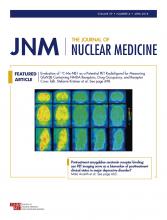TO THE EDITOR: We have enthusiastically read the meticulous and well-conducted retrospective study by Bauckneht et al. published in the October issue of The Journal of Nuclear Medicine (1). The authors assessed the role of 18F-FDG PET/CT in the prediction of doxorubicin cardiac toxicity in 69 patients treated with a chemotherapy regimen for Hodgkin lymphoma (HL); furthermore, they investigated the possible dose-dependent nature of doxorubicin toxicity in 15 athymic mice and concluded that in patients undergoing doxorubicin administration, not only is myocardial 18F-FDG uptake increased but also that low 18F-FDG uptake before chemotherapy may predict the development of cardiac toxicity.
Myocardial cells protect themselves from hypoxic state, reducing contractile function with the downregulation of hypoxia and mitochondrial oxidative metabolism through the “glucose-fatty acid cycle” (2), and 18F-FDG uptake may be a useful tool to identify a myocardial metabolic switch subsequent to cellular damage (3).
Several published retrospective and preclinical studies, some already cited by Bauckneht et al. (4,5), suggest the opportunity of investigating the correlation between changes in myocardial 18F-FDG uptake in pre- and postchemotherapy or radiotherapy evaluation and subsequent development of cardiac toxicity (6,7).
We also observed in a preliminary study that cardiac uptake of 18F-FDG could increase during chemotherapy (8). Our first hypothesis was that in patients undergoing chemotherapy some elements may modify the variable avidity for glucose (9) and shift the myocardial metabolism from β-oxidation of fatty acids to glycolysis, also considering the possible role of steroids (for iatrogenic hyperglycemia) and granulocyte colony-stimulating factor (for insulinlike effects). We tested our hypothesis retrospectively in a group of HL patients (n = 24) treated with a regimen of adriamycin, bleomycin, vincristine, dacarbazine (ABVD) plus 20 mg of dexamethasone, excluding patients with antecedent cardiovascular disease, diabetes, and previous chemotherapy or mediastinal irradiation and identifying 10 patients who received from 50 to 575 mg of steroids additional to the standard (extra-steroids group).
All patients underwent 18F-FDG PET/CT at staging, interim, and final evaluation: no significant differences were found between different scans in patients’ body weight and glycemia levels at 18F-FDG injection. We observed also an incremental trend in cardiac SUVmax at staging, interim, and final evaluation, and we found a significant association between 18F-FDG uptake and extra-steroid administration (P = 0.005), suggesting a strong, independent (and possibly transient) correlation between administration of extra steroids and this phenomenon.
The correlation between cardiac toxicity after chemotherapy, in particular after anthracycline administration, or radiotherapy and myocardial 18F-FDG uptake is a current study argument.
Given the aforementioned data, it is our opinion that 18F-FDG PET/CT may be a useful biomarker of cardiac toxicity, but only after first clarifying the role of other factors that may occur as confounders in 18F-FDG uptake, such as steroid administration.
Footnotes
Published online Jan. 11, 2018.
- © 2018 by the Society of Nuclear Medicine and Molecular Imaging.







